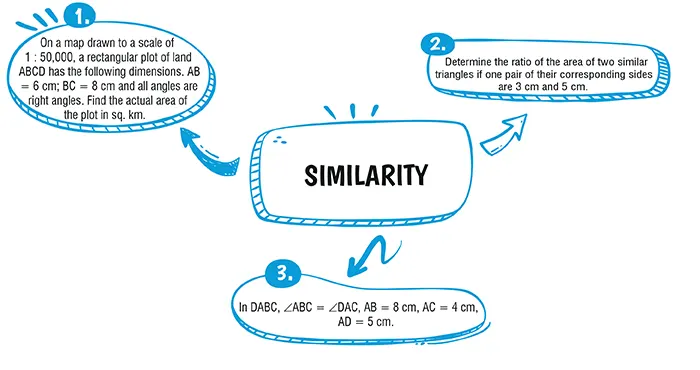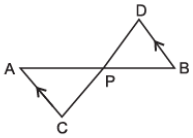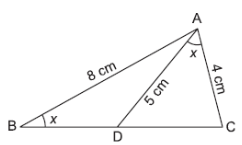

The chapter on "Similarity" in ICSE Class 10 Mathematics explores the concept of geometric similarity, which is fundamental in solving various real-world problems. Students learn about similar triangles, a key topic in this chapter, and how to identify them using certain criteria like the Angle-Angle (AA) similarity criterion. Understanding the properties of similar figures, including polygons, circles, and their corresponding angles, is a crucial aspect of this chapter. The chapter delves into the applications of similarity in solving problems related to indirect measurement, such as height and distance calculations. Here's an introductory overview of similarity class 10 ICSE board questions.
In Similarity of class 10 ICSE chapter the concept of "Similarity" is a fundamental topic within the realm of geometry. This chapter explores the principles of similarity, which involves the comparison of geometric figures that have the same shape but possibly different sizes.
Here's an introductory overview of the concept of "Similarity" in ICSE Class 10 Mathematics:
"In the world of geometry, 'Similarity' takes center stage in ICSE Class 10 Mathematics. This fundamental concept revolves around the comparison of shapes that share the same form or structure but may differ in size. Similarity plays a pivotal role in understanding relationships between geometric figures, from triangles to more complex shapes.
Throughout this chapter, students will delve into the principles of similarity, exploring how to identify, prove, and apply similarity in various scenarios. The study of similarity not only enhances their geometric reasoning but also equips them with problem-solving skills that have practical applications in fields such as architecture, engineering, and design.
In ICSE Class 10 Mathematics, "similarity" is like finding twins among geometric shapes. It's when shapes have the same form or structure but can be different in size. Imagine you have two triangles that look exactly alike, but one is larger than the other. They are similar because their shapes match, even though they're not the same size.
Similarity of class 10 ICSE means having the same shape, just like how identical twins have the same face, but one might be taller or shorter than the other. In geometry, we use similarity to compare shapes and figure out their proportions. It's a handy tool for solving all sorts of real-world problems, from resizing pictures to designing buildings.


Ans. (d) AA
Explanation:
Here, In ΔAPC and ΔBPD
∠ APC= ∠ BPD [vertically opposite angles]
∠ ACP= ∠ BDP [Alternate Interior angles]
∴ By AA similarly
ΔAPC ~ ΔBPD
Ans. (b)
Explanation:
Sol. ∵ ΔPQR ~ ΔPST,
∴ \(\frac{PQ}{PS}=\frac{QR}{ST}=\frac{PR}{PT}\)
⇒\(\frac{PQ}{PS}= \frac{PR}{PT}\)
Or \(\frac{PQ}{PR}= \frac{PS}{PT}\)
Explanation:
Here, 1 : k = 1 : 50,000
and AB = 6 cm, BC = 8 cm

Area of rectangle ABCD
= 6 × 8 = 48 cm2
∴ Actual area = k2× Area of ABCD
= (50‚000)2 × 48 cm2
=\(\frac{50,000×50,000×48}{1,00,000×1,00,000} km^2\)
= 12 km2.
Explanation:
Let the two triangles be ABC and DEF
Let BC = 3 cm and EF = 5 cm.
Then \(\frac{Area(\Delta ABC)}{Area(\Delta DEF)}=\frac{(BC)^2}{(BC)^2}\)
=\(\frac{3^2}{5^2}\)= 9 : 25.

Explanation:
∠ABC = ∠DAC = x (say)
Given, AB = 8 cm, AC = 4 cm and AD = 5 cm.

(i) In Δ ACD and Δ BCA,
∠ ABC = ∠ DAC (Given)
∠ ACD = ∠ BCA (Common)
⇒ Δ ACD ~ Δ BCA (By AA axiom)
Hence, Δ ACD is similar to Δ BCA.
(ii) As we have,
\(\frac{AC}{BC}=\frac{CD}{CA}=\frac{AD}{BA}\)
⇒ \(\frac{4}{BC}\)=\(\frac{CD}{4}\)=\(\frac{5}{8}\)
⇒ \(\frac{4}{BC}\)=\(\frac{5}{8}\)
⇒ BC =\(\frac{8×4}{8}\)=\(\frac{32}{5}\)= 6 . 4 cm.
and \(\frac{CD}{4} = \frac{5}{8}\)
⇒ CD = \(\frac{5×4}{8} = \frac{32}{5} \) = 2.5 cm.
(iii) \(\frac{Area\space of \Delta ACD}{Area\space of \Delta ABC}\)=\(\begin{pmatrix}\frac{AC}{AB} \end{pmatrix}^2\)
= \(\begin{pmatrix}\frac{4}{8} \end{pmatrix}^2=\frac{1}{4}\)
Thus, area of Δ ACD: area of Δ ABC = 1 : 4.


In conclusion, Similarity of class 10 ICSE the study of similarity in ICSE Class 10 Mathematics provides students with a powerful tool for understanding and comparing geometric figures that share the same shape but may differ in size. Throughout this chapter, students have explored the principles of similarity, discovering how to identify, prove, and apply it in various contexts.
The concept of similarity not only enriches students' geometric reasoning but also equips them with valuable problem-solving skills. It allows them to analyze and resize shapes while maintaining their proportions, which has practical applications in fields such as architecture, engineering, and design.
If you want to get better at this chapter and really understand it, check out oswal.io. Oswal.io has lots of similarity questions class 10 ICSE to help you practice and get a deeper grasp of the ideas. It's like having a treasure chest of knowledge to make you a math wizard!
Ans: Similarity is a geometric concept where two or more figures have the same shape but may differ in size.
Ans: Two figures are similar if their corresponding angles are equal, and the ratios of their corresponding sides are in proportion.
Ans: Similarity is used for scaling and resizing objects, such as maps, architectural designs, and models, while preserving their proportions.
Ans: The ratio of corresponding sides in similar figures is called the "scale factor."
Ans: Yes, all equilateral triangles are similar because they have the same shape and their angles are equal.